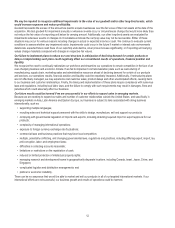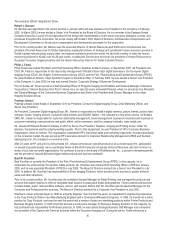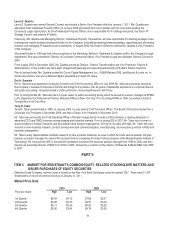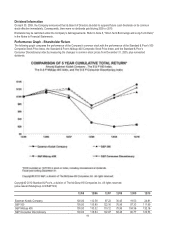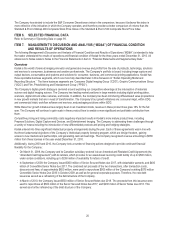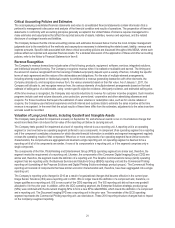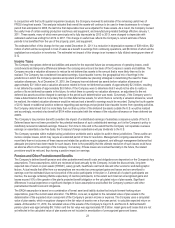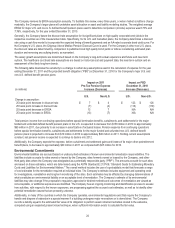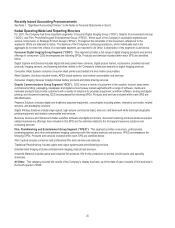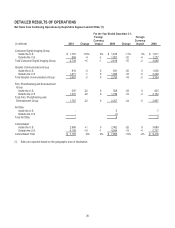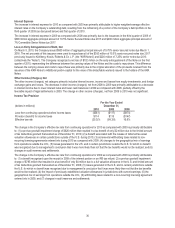Kodak 2010 Annual Report Download - page 24
Download and view the complete annual report
Please find page 24 of the 2010 Kodak annual report below. You can navigate through the pages in the report by either clicking on the pages listed below, or by using the keyword search tool below to find specific information within the annual report.22
Goodwill is tested by initially comparing the fair value of each of the Company’s reporting units to their related carrying values. If the
fair value of the reporting unit is less than its carrying value, the Company must determine the implied fair value of the goodwill
associated with that reporting unit. The implied fair value of goodwill is determined by first allocating the fair value of the reporting
unit to all of its assets and liabilities and then computing the excess of the reporting unit’s fair value over the amounts assigned to the
assets and liabilities. If the carrying value of goodwill exceeds the implied fair value of goodwill, such excess represents the amount
of goodwill impairment charge that must be recognized.
Determining the fair value of a reporting unit involves the use of significant estimates and assumptions. The Company estimates the
fair value of its reporting units utilizing income and market approaches through the application of discounted cash flow and market
comparable methods, respectively. To estimate fair value utilizing the income approach, the Company established an estimate of
future cash flows for each reporting unit and discounted those estimated future cash flows to present value. Key assumptions used
in the income approach were: (a) expected cash flows for the period from October 1, 2010 to December 31, 2015; and (b) discount
rates of 15% to 28%, which were based on the Company’s best estimates of the after-tax weighted-average cost of capital of each
reporting unit. To estimate fair value utilizing the market comparable methodology, the Company applied valuation multiples, derived
from publicly-traded benchmark companies, to operating data of each reporting unit. Benchmark companies are selected for each
reporting unit based on comparability of the underlying business and economics, and if they could potentially purchase the reporting
unit. Key assumptions used in the market approach include the selection of appropriate benchmark companies and the selection of
an appropriate market value multiple for each reporting unit based on a comparison of the reporting unit with the benchmark
companies as of the impairment testing date. Both the income and market approaches estimate fair values based on ability to
generate earnings and are, therefore, meaningful in estimating the fair value of each of the Company’s reporting units. The use of
each methodology also provides corroboration for the other methodology. Consistent with prior years, with the exception of the
FPEG reporting unit, the Company determined fair value of each of its reporting units using 50% weighting for each valuation
methodology as we believe that each methodology provides equally valuable information. The Company determined fair value for
the FPEG reporting unit using only the income approach due to the unique circumstances of the film and photofinishing industry.
Based upon the results of the Company’s September 30, 2010 analysis, no impairment of goodwill was indicated.
A 20 percent change in estimated future cash flows or a 10 percentage point change in discount rate would not have caused a
goodwill impairment to be recognized by the Company for any of its reporting units as of September 30, 2010. Impairment of
goodwill could occur in the future if market or interest rate environments deteriorate, expected future cash flows decrease, or if
reporting unit carrying values change materially compared with changes in respective fair values.
The Company’s long-lived assets other than goodwill are evaluated for impairment whenever events or changes in circumstances
indicate the carrying value may not be recoverable.
When evaluating long-lived assets for impairment, the Company compares the carrying value of an asset group to its estimated
undiscounted future cash flows. An impairment is indicated if the estimated future cash flows are less than the carrying value of the
asset group. The impairment is the excess of the carrying value over the fair value of the long-lived asset group.
In December 2010, the FASB issued ASU No. 2010-28, "When to Perform Step 2 of the Goodwill Impairment Test for Reporting
Units with Zero or Negative Carrying amounts," which amends ASC Topic 350, "Intangibles – Goodwill and Other." ASU No. 2010-
28 requires entities that have a reporting unit with a negative carrying value to assess whether qualitative factors indicate that it is
more likely than not that an impairment of goodwill exists, and if an entity concludes that it is more likely than not that an impairment
exists, the entity must measure the goodwill impairment. This update is effective January 1, 2011 for the Company. The FPEG
reporting unit had a negative carrying amount as of September 30, 2010 for purposes of the annual goodwill impairment test.
Due to the continuing challenging business conditions facing FPEG including a sustained fourth quarter escalation in commodity
prices (the price of silver increased 39%, or $8.56 per troy ounce from the September 30, 2010 closing price to $30.63 per troy
ounce at the December 31, 2010 closing price), and ongoing declines in the FPEG business caused by digital substitution, the
Company evaluated the long-lived assets of FPEG’s film business and paper and output systems business for impairment, and
updated its goodwill impairment analysis of the FPEG reporting unit as of December 31, 2010. Based on this evaluation, with the
exception of goodwill, the Company concluded that there were no impairments of FPEG’s long-lived assets.
Certain assumptions used to determine the fair value and carrying amount of the FPEG reporting unit for purposes of the goodwill
impairment test were revised, as of December 31, to reflect: (1) reductions in future expected cash flows due to the actual results for
the fourth quarter of 2010 and revised forecasts for 2011 and later years; and (2) revision of which liabilities would be considered in
determining the fair value of the reporting unit, as the updated cash flows could no longer support all of the previously allocated
liabilities. Based on its updated analysis, the Company concluded that there was an impairment of goodwill related to the FPEG
reporting unit of $626 million as of December 31, 2010.
As a result of the updated goodwill impairment analysis and the impairment charge recorded in the fourth quarter of 2010 for FPEG,
ASU No. 2010-28 will not have an impact on the Company.


